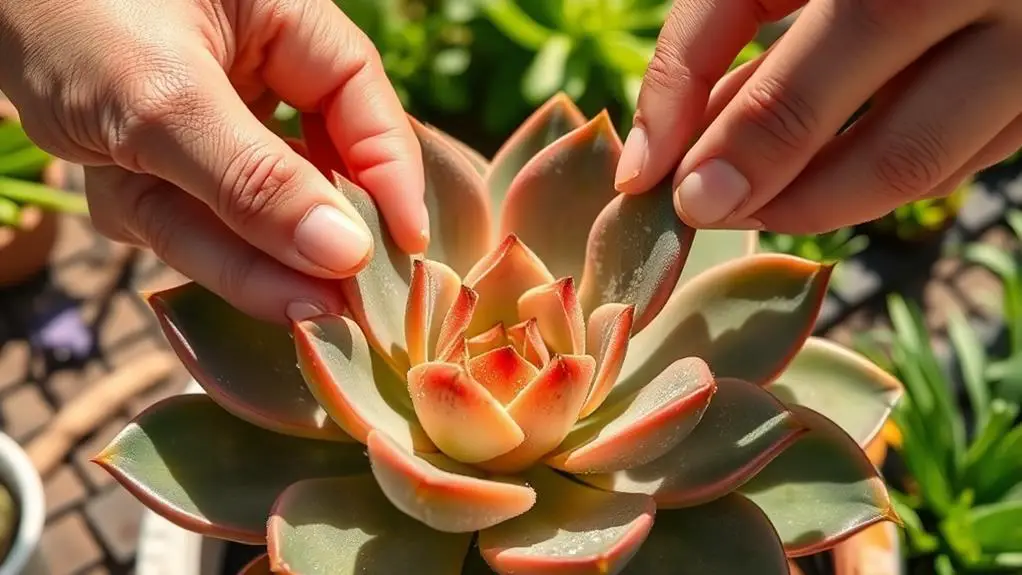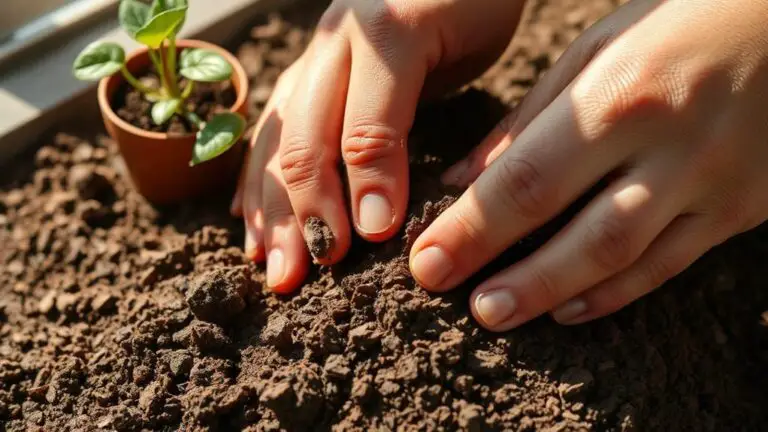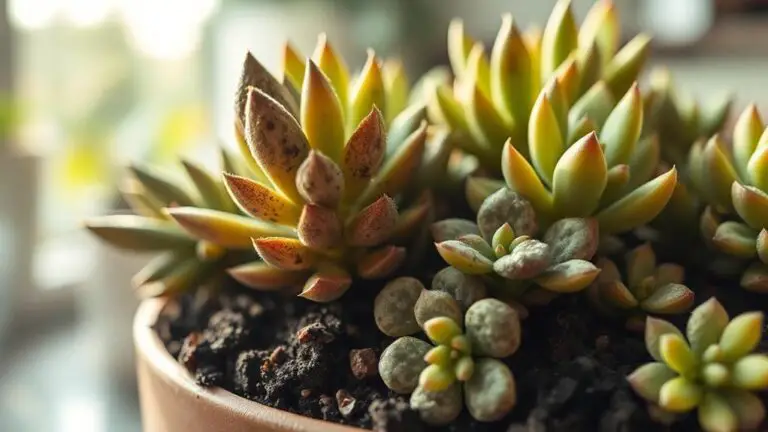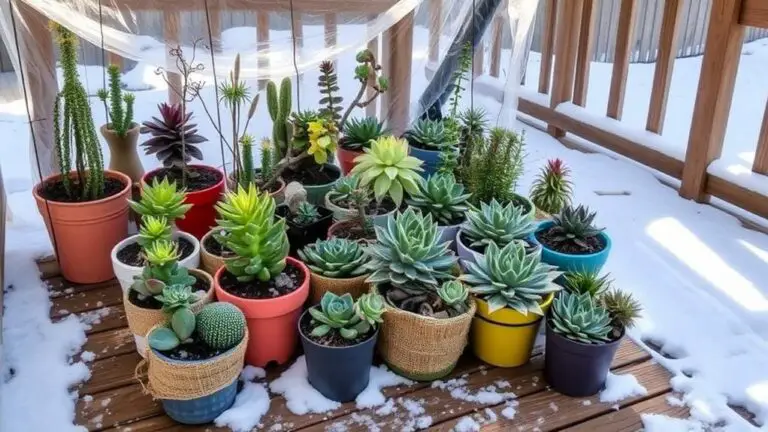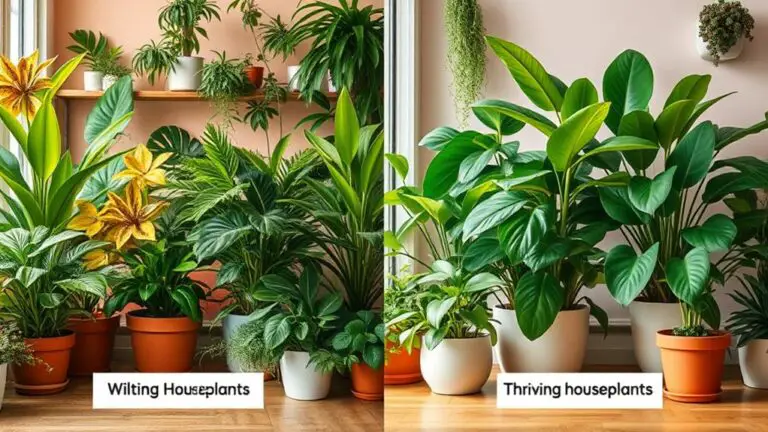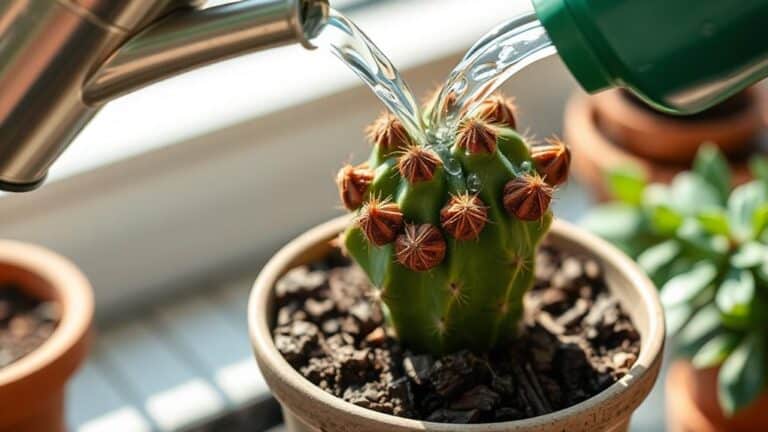How to Treat Edema in Succulents: A Step-by-Step Guide
Treating edema in succulents starts with recognizing those telltale raised, blister-like bumps on the leaves. You need to guarantee your plants have proper drainage by using a well-draining soil mix and pots with adequate holes. Adjusting your watering techniques is essential—let the soil dry out completely between waterings and monitor moisture levels regularly. Reducing humidity and increasing light exposure also play significant roles in promoting healthier growth. So, how exactly do you balance all these factors to keep your succulents thriving? Let's explore each step in more detail.
Understanding Succulent Edema
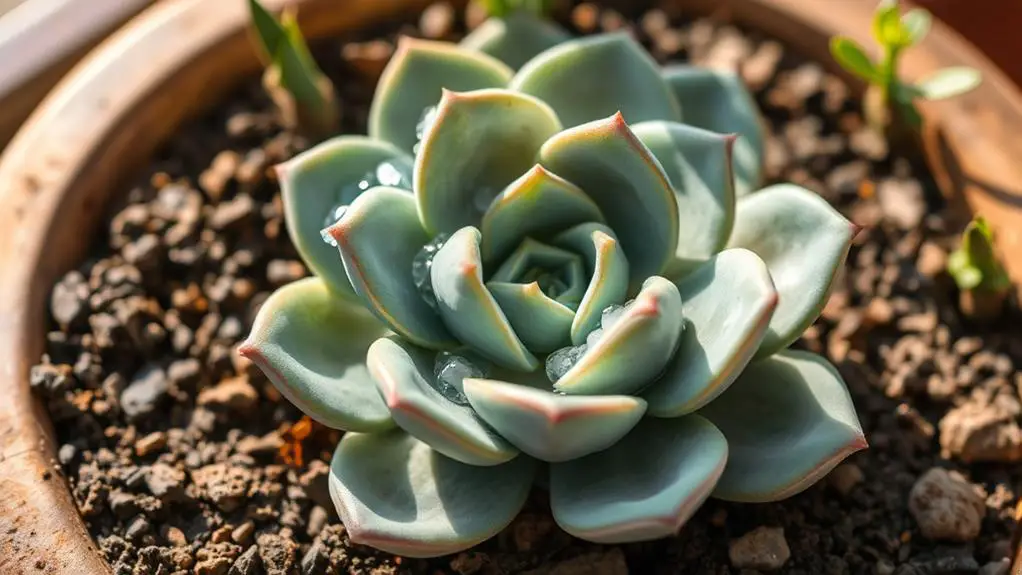
Although succulents are known for their drought tolerance, they can still fall victim to edema, a disorder caused by excessive water absorption. Succulent edema happens when the plant takes in more water than it can handle, leading to the rupture of leaf cells. This results in raised, pimple-like spots on the leaves.
Overwatering is often the main culprit, but poor drainage and high humidity can also contribute by slowing down the plant's ability to release moisture through transpiration.
When succulent edema first appears, you'll notice water-soaked spots on the leaves. These spots can later develop into brownish, corky textures as the affected cells rupture and dry out.
While these edema spots aren't harmful and won't spread, they do signal a moisture imbalance that needs addressing. It's crucial to catch these signs early. Early detection gives you the chance to adjust your watering practices and improve the plant's environment, helping you manage the condition effectively.
Common Causes of Edema
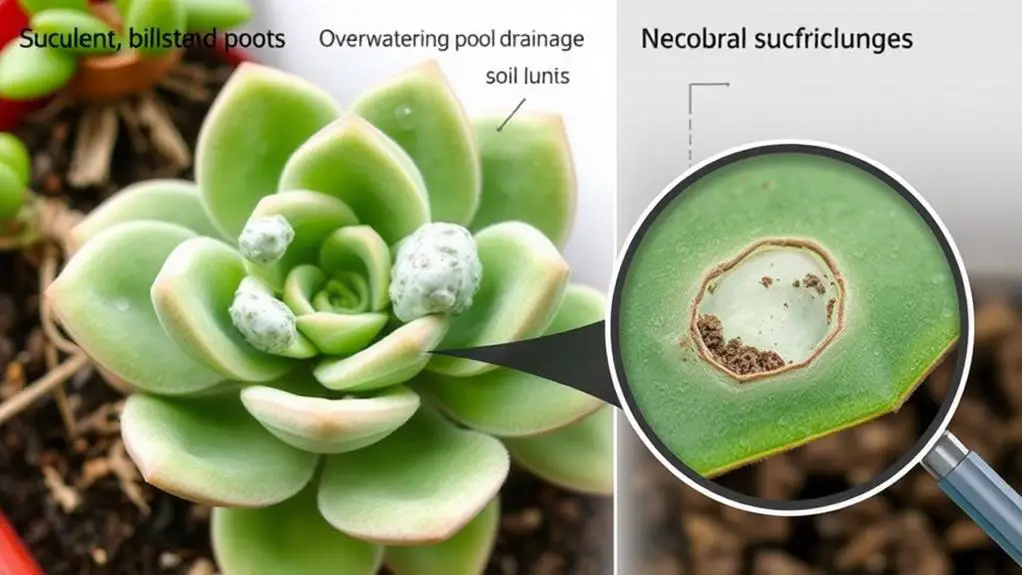
Overwatering is the primary cause of edema in succulents, leading to an excess of moisture that the plants can't adequately utilize. When you water your succulents too often, the roots absorb more water than they can transpire, causing cells to swell and eventually rupture. This imbalance leads to edema.
Another common cause is poor drainage. If your soil is too compact or non-porous, it will retain water, creating the perfect storm for edema. Succulents need well-draining soil to prevent water retention and allow proper root function.
High humidity also plays a role. In environments with high humidity, transpiration slows down. This means your succulents can't release water as quickly, leading to more water retention and increased risk of edema. Seasonal changes can further complicate things, especially during periods of rapid growth when plants may need adjustments in watering practices.
Here's a quick table to summarize:
| Cause | Effect on Succulents |
|---|---|
| Overwatering | Excess moisture, cell rupture |
| Poor Drainage | Increased water retention |
| High Humidity | Slowed transpiration, more edema |
Identifying Edema Symptoms
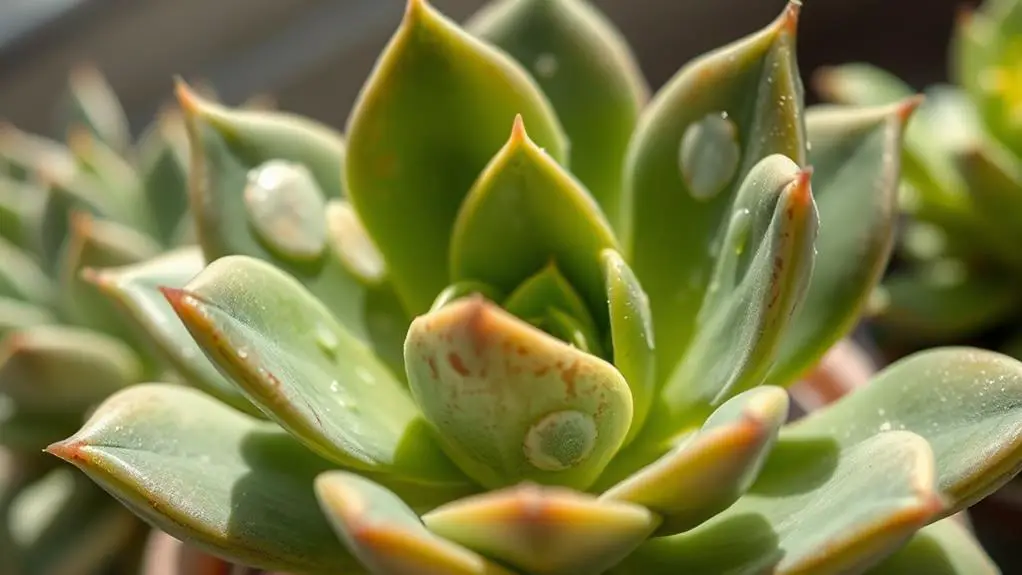
Understanding the common causes of edema sets the stage for recognizing its symptoms. Edema in succulents often begins with raised, wart-like bumps on the leaves. These bumps look water-soaked at first, almost like tiny blisters. As they develop, they can turn into light, pimple-like growths.
Don't confuse these symptoms with pest damage or disease. Accurate identification is essential for effective treatment.
As edema progresses, the bumps may turn brown or necrotic, giving the leaves a corky texture. This happens because the cells rupture due to excess moisture. If you notice these symptoms, it's likely a sign of a moisture imbalance.
Early detection is key to managing edema and preventing further damage to your succulent. Initially, the signs may look like a skin rash, indicating that your plant has absorbed too much water.
By recognizing these symptoms early, you can take steps to reduce moisture and treat your succulent more effectively. Keep an eye out for these specific changes in your plant's appearance, and you'll be better prepared to address edema promptly.
Checking Soil Drainage
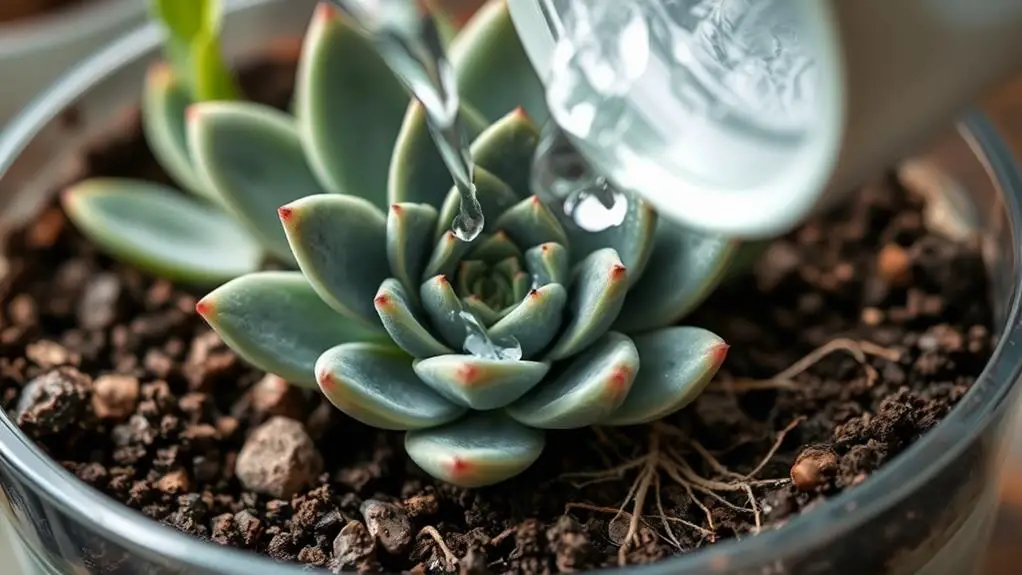
To make sure your succulent's soil drains well, pick a mix that has both organic materials like peat and inorganic ones like perlite for good air flow and moisture control.
Always use pots with drainage holes so extra water can escape, helping prevent edema.
Check the soil texture; it should crumble easily, not feel compacted or soggy, which shows good drainage.
Importance of Soil Composition
Guaranteeing proper soil composition is vital for preventing edema in succulents. A well-draining soil keeps your plants healthy by avoiding water retention, which can cause edema. For the best results, mix 2 parts potting soil, 1 part perlite, and 1 part coarse sand. This combination creates a soil that drains well and allows for good aeration.
Regularly checking the soil moisture is also essential. Use a moisture meter or the chopstick method to guarantee the soil dries out completely between waterings. Overwatering can lead to edema, so these tools help you keep the moisture levels in check.
Choosing the right pot is equally important. Always select pots with drainage holes to prevent water from sitting in the soil. Avoid containers that retain moisture, as they can exacerbate edema symptoms.
| Material | Purpose |
|---|---|
| Potting Soil | Base of the mix |
| Perlite | Enhances drainage |
| Coarse Sand | Improves aeration |
Evaluating Pot Drainage Holes
One of the first steps in preventing edema in succulents is evaluating the drainage holes in your pots.
It's important to confirm your pots have adequate drainage holes at the bottom. These holes allow excess water to escape, preventing waterlogged soil that can cause edema. When water can't drain properly, it leads to moisture retention, which is harmful to succulents.
Using a well-draining soil mix is also vital.
Combine organic materials like potting soil with inorganic ones, such as perlite or sand, to enhance drainage. This mix helps avoid overwatering, a common issue for succulents.
Regularly check the drainage holes for blockages.
Soil or roots can sometimes clog these holes, stopping water from flowing out and leading to moisture retention. If you prefer decorative pots without drainage holes, place your succulent in a smaller pot with drainage first. Then, put that pot inside the decorative one.
Monitor how quickly water drains after watering.
Ideally, it should take only a few minutes for excess water to escape. If the water lingers, it's a sign your pot might need better drainage or a soil mix adjustment.
Benefits of Porous Materials
When it comes to preventing edema in succulents, incorporating porous materials like pumice, perlite, and coarse sand into your soil mix is essential.
These materials enhance drainage and make sure water doesn't stay trapped in the soil, which can lead to edema. By ensuring better airflow around the roots, they help reduce the risk of root rot, a common problem when succulents are overwatered.
A soil mix with at least 30% porous materials allows excess moisture to escape quickly. This is vital for succulents, which are very sensitive to overwatering.
When you use pots with drainage holes, these materials facilitate efficient water evaporation, helping you maintain the right moisture balance for your plants.
Incorporating porous materials also promotes healthy root development. Healthy roots can absorb nutrients and water more effectively, reducing the risk of edema.
This means your succulents will grow stronger and be more resilient.
Choosing the Right Pot
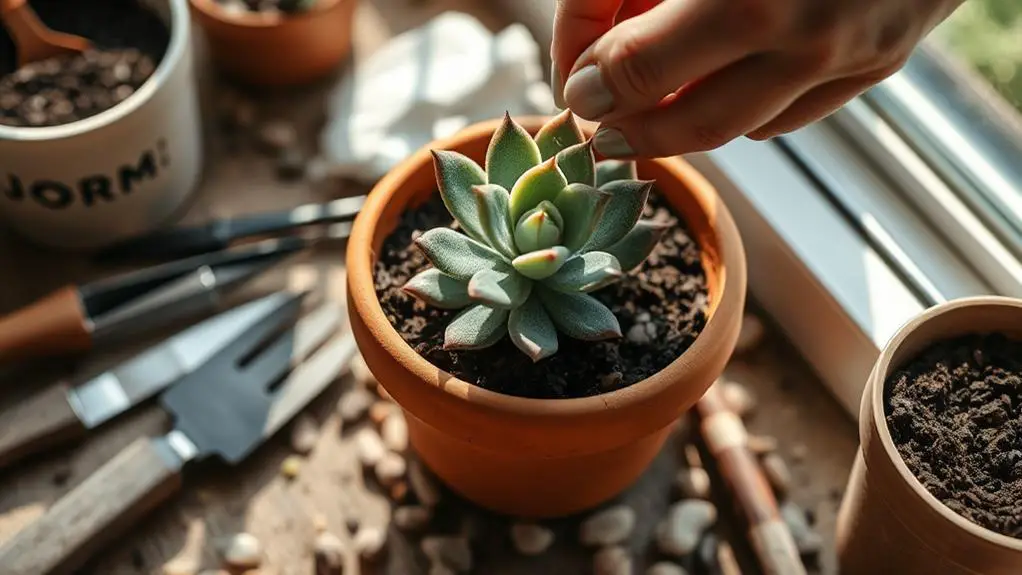
Selecting the right pot is essential for preventing edema in succulents. You need to choose a pot that meets specific criteria to guarantee your succulent stays healthy and happy. Here's what to look for:
- Drainage Holes: Always pick pots with drainage holes. These allow excess water to escape, preventing water retention that can cause edema. Without proper drainage, your succulent's roots can become waterlogged.
- Porous Materials: Opt for pots made of terracotta or ceramic. These porous materials enhance air circulation and moisture evaporation, unlike plastic pots. Good airflow around the roots keeps them dry and healthy.
- Adequate Space: Select a pot that's slightly larger than your succulent's root ball. This provides enough room for growth without retaining too much moisture. If the pot is too large, it can hold excess water, which isn't good for your plant.
Also, guarantee the potting mix you use is well-draining. Mixing in materials like perlite or coarse sand can improve drainage.
Consider the pot's weight and stability as well. Heavier pots can prevent tipping and keep your succulent safe.
Monitoring Soil Moisture
Consistently monitoring soil moisture is essential for preventing edema in succulents. To start, you'll want to use the chopstick method. Insert a chopstick into the soil; if it comes out dry two-thirds down, it's time to water. This simple tool helps you gauge the soil moisture without disturbing your succulent.
Regularly check the top inch of soil. If it feels dry to the touch, it's a sign your succulents may need watering. Keeping a watering schedule that aligns with the seasonal growth patterns is crucial. During the active growing season, succulents will typically require more frequent watering. By adjusting your watering schedule to match these patterns, you'll help prevent overwatering.
Environmental humidity also plays a role. High humidity can slow down the evaporation of moisture from the soil, which means you mightn't need to water as often. It's important to be aware of these conditions to avoid overwatering, which can lead to edema.
For more precise readings, consider using a moisture meter. This tool gives you exact soil moisture levels, ensuring you're providing the right amount of water.
Adjusting Watering Techniques
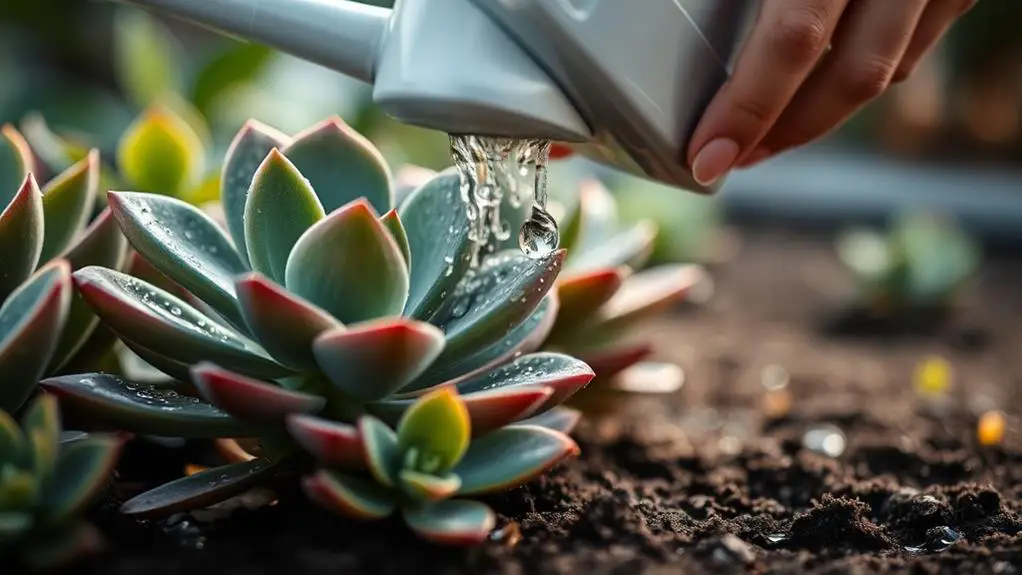
Adjusting your watering techniques is essential for treating and preventing edema in succulents. First, always let the soil dry out completely between waterings. Succulents thrive on a "soak and dry" method, where you thoroughly water the plant and then wait until the soil is dry before watering again. This prevents excess moisture, which can cause edema.
Next, use a well-draining potting mix. This mix should include both organic and inorganic materials to help with proper drainage.
Here's a quick guide to help you adjust your watering techniques:
- Monitor Moisture Levels: Use a moisture meter or the chopstick method to check the soil's moisture. Insert a chopstick into the soil and see if it comes out clean or with soil sticking to it.
- Adjust Seasonal Watering: Water less in the winter when succulents are dormant and need minimal moisture. Increase watering slightly during their active growing season in the spring and summer.
- Try Bottom-Watering: Place the pot in a shallow dish of water. Let the soil absorb moisture from the bottom up, ensuring it's not overly saturated.
These steps will help you maintain healthy succulents and prevent edema from occurring.
Enhancing Light Exposure
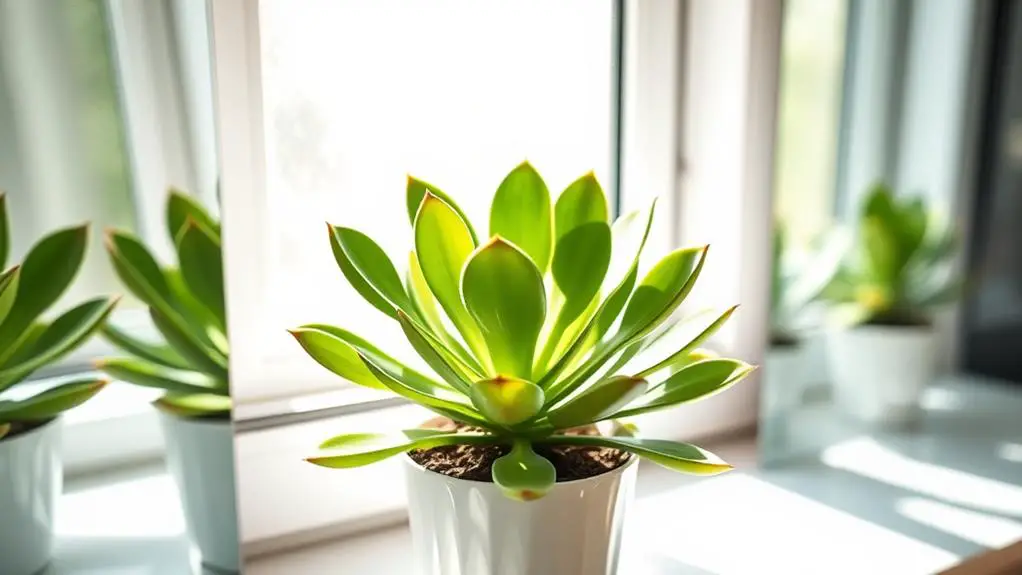
To help your succulents avoid edema, try increasing their light exposure.
Place them near south or west-facing windows to maximize natural sunlight, or use grow lights if your home doesn't get enough light.
Don't forget to rotate your plants regularly to guarantee all sides get equal light, promoting even growth and reducing moisture issues.
Increase Natural Sunlight
Increasing natural sunlight exposure is essential for treating edema in succulents. By doing so, you help your plants utilize water more efficiently, reducing the chances of edema through improved transpiration.
To start, aim to provide at least 6 hours of bright, indirect sunlight daily. This kind of light exposure supports healthy growth and maintains the moisture balance in your succulents.
Here are a few steps to help you increase natural sunlight for your succulents:
- Find the Right Spot: Place your succulents near south or west-facing windows. These windows usually receive the most light, maximizing their exposure to natural sunlight.
- Gradual Acclimation: If you're moving your succulents outdoors, do it gradually. This prevents leaf scorch and reduces further stress on your plants.
- Monitor and Adjust: Keep an eye on your succulents and adjust their position if they're not getting enough light. Sometimes, even a small change in location can make a big difference.
Use Artificial Grow Lights
When natural sunlight is insufficient, artificial grow lights become an essential tool for enhancing light exposure in succulents. They're especially useful during the shorter days of fall and winter.
Artificial grow lights can provide the necessary intensity and spectrum of light that succulents require to thrive.
LED grow lights are a fantastic choice. They're energy-efficient, produce less heat, and can be adjusted for different growth stages of your succulents, ensuring ideal light exposure without overheating.
Position your grow lights about 6 to 12 inches above the plants, but adjust the height based on the light's wattage and your specific succulent species to avoid light burn.
A 12 to 16-hour light cycle is recommended. This mimics natural conditions and supports healthy growth and transpiration.
Rotate Plants Regularly
Regularly rotating your succulents every 1-2 weeks is essential for guaranteeing they receive equal light exposure on all sides.
By doing this, you help your plants grow evenly and reduce the risk of edema caused by uneven moisture absorption. Succulents need at least 6 hours of bright, indirect sunlight daily.
When you rotate plants regularly, they can maintain this light requirement and stay healthy.
Here are three key benefits of rotating your succulents:
- Even Growth: Rotating your plants guarantees that all sides get the same amount of light, promoting balanced growth and preventing weak stems and leaves.
- Prevent Sunburn: Gradually rotating succulents when moving them outdoors helps acclimatize them to direct sunlight, preventing sunburn and the stress that can contribute to moisture imbalance and edema.
- Early Detection: Consistent rotation allows you to inspect all leaf surfaces and overall plant condition regularly, making it easier to catch early signs of edema or other issues.
Nutrient Management
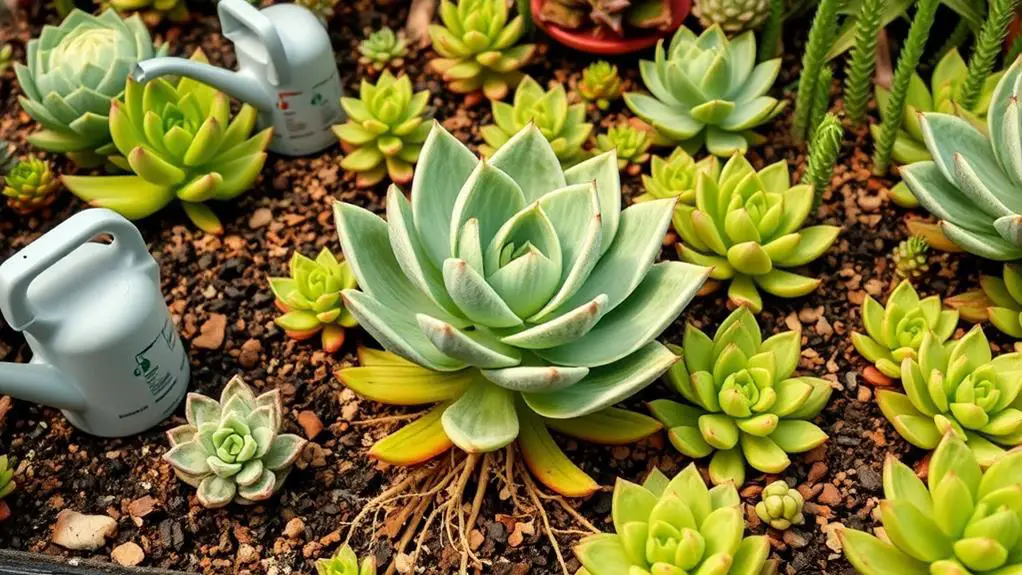
Ensuring proper nutrient management is essential for maintaining succulent health and preventing edema. You should always monitor your plant's nutrient levels, focusing on potassium, magnesium, and calcium. These nutrients play an important role in helping your succulent manage water efficiently, reducing the risk of edema.
Using a balanced fertilizer during the growing season can make a substantial difference. It enhances nutrient absorption, helping your plant recover from edema and promoting new, healthy growth. However, be careful to avoid over-fertilization, especially when your succulent is in dormancy. Too much fertilizer can cause water retention issues, which can lead to edema.
Regularly testing your soil nutrient levels is another great practice. It helps you identify any deficiencies or imbalances early on, so you can adjust your nutrient management practices accordingly. This proactive approach can make a noteworthy impact on preventing edema.
Adding compost or organic matter to your soil is also beneficial. It improves nutrient availability and soil structure, promoting better drainage. This can greatly reduce the likelihood of edema formation.
Regular Care and Monitoring

Keeping a close eye on your succulents is vital for preventing and managing edema. Regular care and monitoring can make a huge difference in your plants' health.
Start by checking the soil moisture levels. You can use the chopstick method: insert a dry chopstick into the soil and see if it comes out clean. If it does, the soil is dry and ready for watering. Overwatering is a common cause of edema, so verify the soil is completely dry before you water again.
Next, monitor the humidity levels in your growing environment. High humidity can worsen edema, so try to maintain low humidity conditions. Succulents thrive in dry air, and you can use a dehumidifier if needed.
It's also essential to inspect your succulents weekly for any signs of edema, like water-soaked spots or raised bumps. Early detection allows you to adjust care quickly and prevent further damage.
Remember these three steps:
- Check soil moisture levels regularly to avoid overwatering.
- Monitor humidity levels to verify they stay low.
- Inspect your succulents weekly for early signs of edema.
Frequently Asked Questions
How to Treat Succulent Edema?
To treat succulent edema, guarantee proper drainage, gradually increase light, and adjust nutrient levels focusing on potassium, magnesium, and calcium. Water only when soil is dry, and inspect leaves regularly for new healthy growth.
How to Treat Edema on Plants?
You can treat edema on plants by improving drainage, increasing light exposure, and adjusting nutrient levels. Monitor your watering habits closely, ensuring soil dries between sessions. Be patient; new growth will emerge as the plant recovers.
Is Plant Edema Reversible?
No, plant edema isn't reversible. Once cells rupture, the damage becomes permanent corky tissue. However, with proper care, you can prevent further damage and guarantee new, healthy growth. Early detection and management are essential for plant health.
Should I Remove Leaves With Edema?
You should remove leaves with edema if they're severely damaged, unsightly, or starting to rot. Use clean, sharp scissors to avoid spreading disease. Monitor your plant afterward to see if any care adjustments are needed.
Conclusion
You've got this! By checking your succulents for edema, ensuring proper drainage, and adjusting your watering habits, you're well on your way to healthier plants. Don't forget to give them plenty of light and monitor their environment regularly. With these steps, you'll prevent edema and help your succulents thrive. Remember, consistent care and a little patience go a long way. Keep up the great work, and soon your succulents will thank you!

